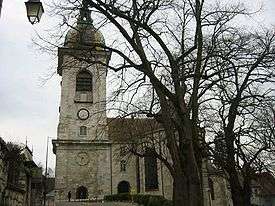Besançon Cathedral


The Cathedral of Saint John of Bensançon (French: Cathédrale Saint-Jean de Besançon), commonly known as Besançon Cathedral, is a Roman Catholic church located in the town of Besançon, France. It is the seat of the Archbishop of Besançon.
The cathedral is situated near the base of Mont Saint-Étienne, below the citadel. To the east of the cathedral is the 16th century Porte Rivotte, with two round towers, and pedestrian walkways dating to the 19th century. To the west is the Porte Noire, a Roman triumphal arch of the 2nd century with extensive sculptural decoration.
The cathedral consists of a large nave between two aisles, and dates from the 11th to the 13th century, with an 18th-century choir.
It contains several valuable paintings, including a "Virgin and Child with Saints" by Fra Bartolommeo (1518). It also has an unfinished alabaster Pietà by the 16th-century artist Conrat Meit.
In the clock tower there is a noteworthy 19th-century astronomical clock with thousands of moving parts and several animated functions.
Burials
In fiction
Chapter 28, "A Procession," in Stendhal's novel Le Rouge et le Noir (The Red and the Black, 1830) takes place in Besançon Cathedral and includes a description of the cathedral decorations for the Feast of Corpus Christi.
See also
External links
| Wikimedia Commons has media related to Besançon Cathedral. |
Coordinates: 47°14′1″N 6°1′50″E / 47.23361°N 6.03056°E